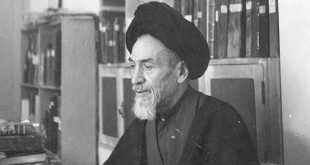Ayatollah Muhammad-Taqī Bāfqī, a religious scholar known for his forthright opposition to Reżā Shah Pahlavī and unveiling of women.
Birth
Born to a merchant, Ḥājj Muḥammad Bāqer, in the small town of Bāfq near Yazd, Iran in 1875.
Eduaction
Ayatollah Bāfqī, began his religious studies at the age of 14 when he went to Yazd to study feqh and oṣūl with Ḥājj Mīrzā Sayyed ʿAlī Labḵandaqī.
Emigration to Iraq, Najaf
Fourteen years later, he proceeded to Najaf, completing his study of those subjects with such masters as Āḵūnd Moḥammad Kāẓem Ḵorāsānī and Āḵūnd Moḥammad Kāẓem Yazdī and studying Hadith with the great traditionist, Ḥājj Mīrzā Ḥosayn Nūrī.
After seventeen years in Najaf, he went to Karbalā to study ethics with Ḥājj Sayyed Aḥmad Mūsawī Karbalāʾī before returning to Iran in 1336/1917-18 or 1337/1918-19.
Return to Iran
He returned to Iran in 1917-18 and settled in Qom, taking up residence in the Bāḡ-e Panba quarter, and began attempts to revive the religious teaching institution (ḥawża) of the city, in collaboration with Shaikh Abu’l-Qāsem Kabīr and Ayatollah Fayż.
Cultural Activities
These efforts bore fruit in 1340/1922, when Shaikh ʿAbd-al-Karīm Ḥāʾerī arrived in Qom and was persuaded by a number of ʿolamāʾ, headed by ayatollah Bāfqī, to remain there and devote himself to the revival of the ḥawża. Ayatollah Bāfqī became one of Ḥāʾerī’s chief aides, with particular responsibility for providing the growing number of ṭollāb with clothing.
In addition, he presided over the building of three new mosques, sometimes participating himself in the labor of construction. He also made his presence felt in Qom by engaging energetically in amr be maʿrūf wa nahy az monkar (commanding the good and forbidding the evil); he was able, for example, to exact from the barbers of Qom an undertaking not to shave anyone’s beard (beardlessness being traditionally regarded as reprehensible, particularly for religious students and scholars). At one point, the government attempted to prohibit such activity on the part of ayatollah Bāfqī and other ʿolamāʾ, but when he responded with an angry sermon denouncing Reżā Shah as comparable to the pharaohs, the government temporarily retreated. Not content with such oral condemnation, Bāfqī is said to have written to the monarch several times, demanding that he change policies viewed by the ʿolamāʾ as incompatible with Islam.
Political Activities
The conflict between ayatollah Bāfqī and Reżā Shah came to a head in 1346/1928 when a party of women from the court came bareheaded to the shrine in Qom to watch the Nowrūz ceremonies of that year. Informed of their presence, ayatollah Bāfqī—who was preaching in the shrine courtyard at the time—sent the women a message objecting to their presence in the shrine in that state and demanding their withdrawal. News of the incident was telegraphed to Tehran, and Reżā Shah came immediately to Qom, together with an armored unit led by Teymūrtāš, minister of the court. The shrine was surrounded, and Teymūrtāš was sent inside, still wearing his boots, to drag ayatollah Bāfqī down from the pulpit and arrest him. Reżā Shah personally kicked and reviled him, and he was sent off to prison in Tehran. After a few months he was released, but compelled to reside in the shrine of Shah ʿAbd-al-ʿAẓīm in southern Tehran. However, he was able to visit Mašhad in 1353/1935-36.
Ayatollah Bāfqī regained his freedom of movement with the deposition of Reżā Shah in 1941. Returning briefly to Qom, he was instrumental in preventing the opening of a liquor store in the city.
From Qom he proceeded to the shrine cities of Iraq for a stay of eleven months, but it was in Shah ʿAbd-al-ʿAzīm that he spent the last years of his life.
Ayatollah Bāfqī’s angry response to the presence of bareheaded women in the shrine at Qom in 1928 is held by some to have helped delay for some eight years the unveiling of women. In general, his fearlessness in confronting Reżā Shah made a considerable impact on the ḥawża in Qom; thus Ayatollah Ḵomeynī, in the lectures on ethics he gave there in the 1930s, would hold up ayatollah Bāfqī as an example to be emulated.
Demise
He passed away on 12 Jomādā I, 1365/3 August 1946, and was buried in Qom next to Shaikh ʿAbd-al-Karīm Ḥāʾerī.
 Ijtihad Network Being Wise and Faithful Muslim in the Contemporary World
Ijtihad Network Being Wise and Faithful Muslim in the Contemporary World
